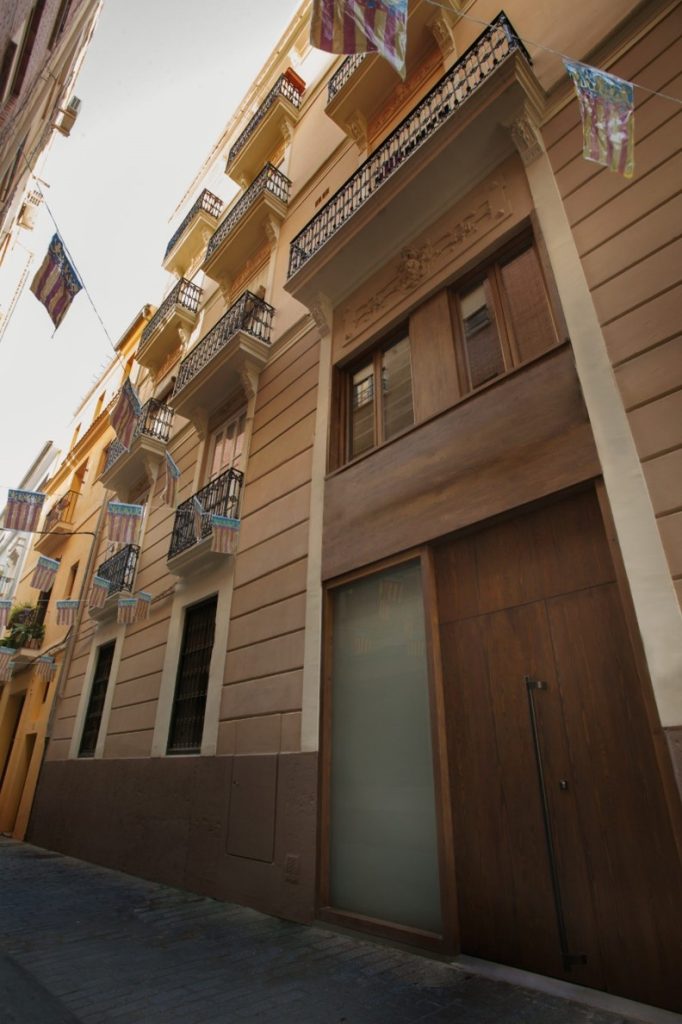Nicolás Greco Nozica. MICCP Student. UPM
Contemporary urban design faces a major challenge in the 21st century: achieving a balance between sustainable development and the conservation of historical heritage. This challenge is particularly important in cities with significant architectural and cultural legacies, such as Valencia. One of the best examples of how sustainability and heritage preservation can coexist harmoniously is the Barrio del Carmen, located in the city’s historic center. Through the rehabilitation of its historic buildings, the promotion of sustainable materials, and the revitalization of its public spaces, this neighborhood has become a model of responsible urban development.

Illustration 1. Location of the Barrio del Carmen on the map of districts in the city of Valencia.
The Barrio del Carmen is one of the oldest and most iconic neighborhoods in Valencia. Its origins date back to the Muslim era, when it was constructed as an expansion of the walled city. Over the centuries, the neighborhood has witnessed numerous urban and social transformations, becoming a key cultural and commercial center for the city. However, during the 20th century, the neighborhood suffered significant deterioration due to neglect and lack of maintenance of its historic buildings. In recent decades, rehabilitation policies have been essential for the neighborhood’s recovery. Strategies have been implemented that seek to maintain its historical essence while adapting to the needs of a modern and sustainable city. According to the Fundación del Patrimonio Histórico de la Comunidad Valenciana (2021), the rehabilitation of the Barrio del Carmen has followed conservation criteria that include the restoration of old façades, the reuse of original materials, and the improvement of energy efficiency in renovated buildings.
One of the main objectives of the Barrio del Carmen rehabilitation has been reducing environmental impact through the use of sustainable techniques and materials. According to the Instituto Valenciano de la Edificación (IVE, 2022), the restoration of historic buildings in the neighborhood has integrated solutions such as the installation of thermal insulation systems, the incorporation of renewable energies, and the use of eco-friendly materials. An example of this integration is the rehabilitation of the neighborhood’s Arab wall, where restoration techniques with clay renders— a natural material that improves wall breathability and reduces humidity— have been used. Additionally, many residential and commercial buildings have been adapted to improve energy efficiency, incorporating LED lighting systems, solar panels, and rainwater reuse mechanisms. The International Union for Conservation of Nature (IUCN, 2023) highlights that the restoration and reuse of old buildings help avoid the construction of new infrastructures, reducing the demand for natural resources and decreasing carbon emissions. In the case of the Barrio del Carmen, the rehabilitation has preserved its historical identity without resorting to mass demolitions or alterations of its original urban structure.
Another key aspect of the Barrio del Carmen transformation has been the recovery of public spaces for citizens to enjoy. The rehabilitation of squares and streets has followed an approach that prioritizes pedestrians, reducing vehicular traffic and promoting sustainable mobility. A notable example is the renovation of Plaza del Árbol, where ecological design elements have been incorporated, such as permeable pavements and native vegetation that helps improve air quality and reduce urban temperatures. According to the Instituto del Patrimonio Cultural de España (IPCE, 2023), the restoration of public spaces within the Barrio del Carmen has not only improved accessibility and safety but also encouraged community life and strengthened the neighborhood’s identity. The recovery of these areas has been essential for the area’s economic revitalization, attracting new businesses and promoting cultural activities without compromising the heritage value of the environment.
The rehabilitation of the Barrio del Carmen would not have been possible without the active participation of its residents. Neighborhood organizations and citizen collectives have played a crucial role in decision-making regarding the conservation and use of historic spaces. Collaboration between the local administration and the community has ensured that rehabilitation projects meet the population’s needs while maintaining the essence of the neighborhood. According to the Valencia City Council (2023), urban rehabilitation plans in the Barrio del Carmen have been developed based on participatory processes, where citizens have been able to express their concerns and proposals. This has been key in preventing gentrification and ensuring that the neighborhood remains an inclusive and accessible space for all.
The Barrio del Carmen in Valencia is an example of how the integration of sustainability with heritage conservation can have a positive impact on the urban environment. Through the rehabilitation of its historic buildings, the incorporation of sustainable technologies, and the recovery of its public spaces, this neighborhood has managed to maintain its cultural identity without renouncing modernity. The successful cases of the Barrio del Carmen restoration demonstrate that urban development does not have to conflict with the protection of historical heritage. On the contrary, when both principles are strategically combined, more livable and sustainable cities are created. In a world where urbanization is rapidly advancing, it is crucial to continue promoting models like the Barrio del Carmen, which respect the past while building the future.

Illustration 2. Rehabilitated fade in the Barrio del Carmen.
References:
- Fundación del Patrimonio Histórico de la Comunidad Valenciana. (2021). Report on the rehabilitation of the Barrio del Carmen. Valencia: FPHCV. https://cultura.gva.es/es/informes-i-resums
- Okambuva Cooperativa. (2021). Clay renders in the rehabilitation of the Barrio del Carmen. Retrieved from www.okambuva.coop
- Instituto del Patrimonio Cultural de España (IPCE). (2023). Report on the restoration of public spaces in historic neighborhoods. https://ipce.cultura.gob.es/difusion/publicaciones/revistas/revista-informes-y-trabajos.html
- Valencia City Council. (2023). Urban rehabilitation plan for the Barrio del Carmen: Citizen participation and sustainability. https://www.valencia.es/es/cas/ayuntamiento/plenodelayuntamiento/-/asset_publisher/0VsIJqf3efBH/content/2023-09-26